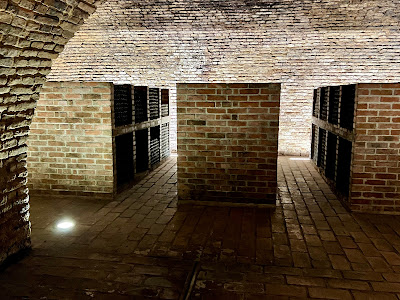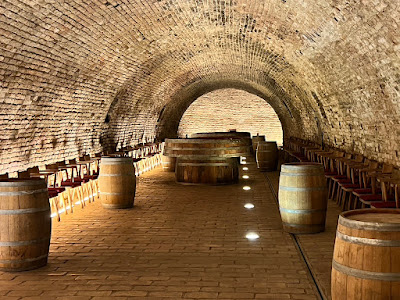During the 16th century, the land of Vina Belje was under the control of the Turks, and remained so for over 100 years. Prince Eugene of Savoy, born of Italian parents, rose to high rank in the Austrian empire and was considered a great military strategist and commander. In 1697, he triumphed ever the Turks at the Battle of Zenta, and due to his great success, he was awarded the estate of Belje. The Prince built a castle near the village of Belje, and also built vineyards, finding the soil to be excellent and rich for grapes, as well as a wine cellar. So, Vina Belje traces their origins back to 1697.
Their wine cellar is one of the largest in Croatia, and there are currently about 330K liters of wine in their old cellar. The vast majority of the barrels in the old cellar contain red wine. There are also some Premium and Goldberg Graševina wines in the barrels there.
In their wine archives, they store about 20,000 bottles, which includes 60 years of Graševina. Now that would be an incredible vertical tasting.
Most of their sales are in Croatia, although they export a small amount of their production, including to U.S. We were also told that Croatia needs to work together to garner greater recognition for their wines. Marketing is vital, and this is a point I heard multiple times during my time in Croatia. Some of those people have stated the country itself hasn't done enough to promote Croatian wines, and that the marketing job will likely fall primarily on associations and individual wineries.
At a Graševina event held elsewhere, I was able to speak briefly with Marijian Knezevic, the enologist of Vina Belje. He had worked at the winery for 15 years but then left for 3 years, before returning to the winery a year ago. During his absence, he primarily engaged in wine consulting. He stated that his winemaking philosophy was "Tradition is always in the future, but don't save the cinder, start new fires."
Marijian returned to the winery because he didn't feel that he had finished the job, as he wanted to take the winery to a new level. He noted that the 1st award from Decanter Magazine, for a Croatian wine, was for his own Merlot. He also noted that his 2009 Grasevina was the Best Awarded 90 point wine, at the lowest price (5.5 Euros) by Robert Parker. Marijian is now producing small production, terroir-driven wines. His top objectives for Belje are to gain recognition for their boutique winery within the larger winery, and also to produce Sparkling wines. He believes he will need 3-5 years to finish his goals.
In 2011, Vina Belje constructed a huge, state-of-the-art winery, at a cost of about 20 Million Euros. Located amidst their vineyards, the winery has a capacity of 8 Million liters, although they are currently only producing about 3.2-3.5 Million liters. There is a fancy wine tasting building located across from the winery, and it can hold 100-150 people. I briefly visited this winery, and it certainly was quite a sight, with so many fermentation tanks extending off into the distance.
The oldest wine in their cellar is a 1949 Cabernet Franc, and they only have 8 bottles left.
We began our tasting of their wines with the NV La Belle Grand Premium Brut, which has an 11.5% ABV and was made by the Charmat Method. The bubbly was fresh, crisp, and elegant, with tasty flavors of green apple, stone fruit, almonds and a hint of toast. It also possessed a pleasing, lengthy finish. A fine way to begin our tasting.
Next, we tasted the 2020 Vina Belje Graševina Select, with a 12.5% ABV;, and which was easy drinking, but not overly simple. It was fresh and fruity, with good acidity, and a bright apple flavor. An excellent summer wine.
The 2021 Vina Belje Graševina Premium, which they had received the day before our tasting, had a 13.5% ABV. It had a compelling fruity nose, and on the palate, it offered a nice complexity, more body, and a lengthier finish than the Select. There were notes of apple and pear, with hints of herbs and spices, especially on the finish. Delicious on its own, this would be an excellent food wine as well.
The 2017 Vina Belje Goldberg Graševina is their ultra-premium level, and the grapes come from a special vineyard. "Goldberg" is a German word for "golden hills." With a 13.5% ABV, this wine spent a year in oak, and then another year in the bottle. It was also very complex, with intriguing notes of spice, honey, apricot, apple, and almonds. It was silky smooth, with a long, lingering finish. An exquisite wine, also indicative of the vast potential of Graševina.
Moving onto a red wine, we tasted the 2019 Vina Belje Frankovka, with a 14% ABV, which spent 1 year in the barrel. This was a delicious wine, deep and intense, with black fruit flavors, prominent spice notes, and restrained tannins. This wine would be best paired with steak or other hearty dishes. Frankovka does so well in the region of Slavonia.
We ended our tasting with the 2015 Vina Belje Pinot Crni (Noir) Premium, with a 14% ABV, :With a medium red color, it was elegant and tasty, with flavors of cherry and raspberry, a touch of spice, mild tannins, and good acidity. Definitely reminded me more of Burgundy than California, and in a similar style to most other Croatian Pinot Noirs. Another winner of a wine.


















No comments:
Post a Comment